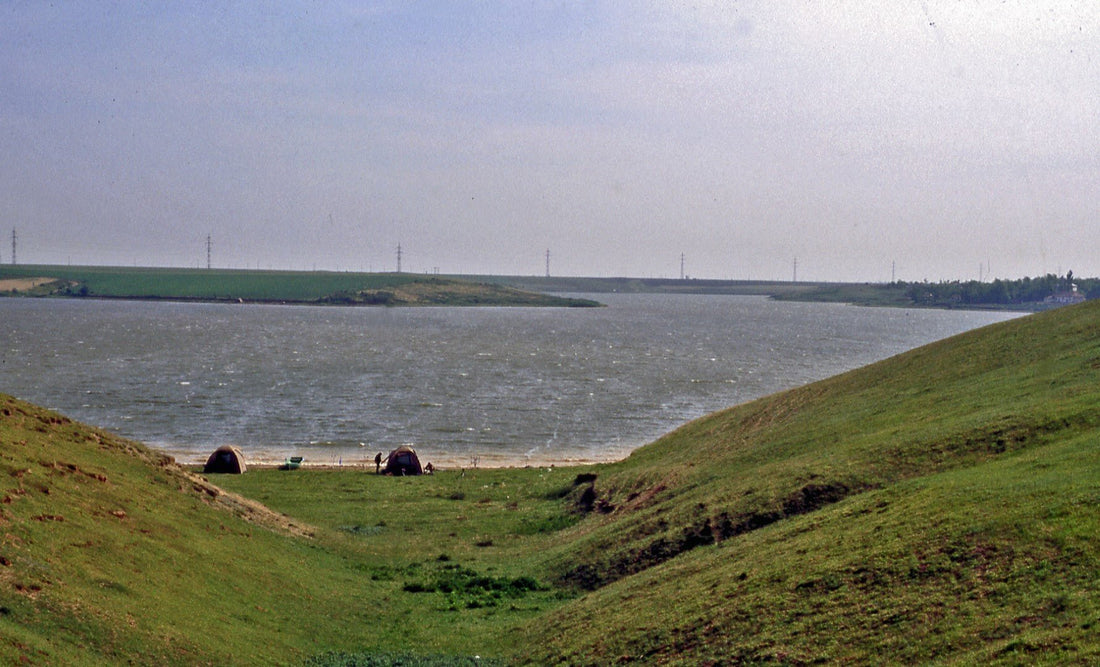
March 2024 Random Ramblings: Fishing Insights by Ken Townley
Share

I have been lucky enough to fish with many of Europe's most successful big-fish carpers and inevitably some of their secrets have rubbed off on lucky old me. For this I am eternally grateful! One of those anglers is Frenchman Philippe Lagabbe, a professional photographer and a prolific catcher of huge carp to boot. This is the cover of an old issue of Carpworld. The photo was taken by Philippe and is one of the few times I have featured on any magazine cover. Thanks, Phil.

Phil applies as much skill to his fishing as he does to his work behind the camera. Clearly it pays off!

We both share a love for DSLR cameras and Phil knows his way around the complexities of a modern digital camera like the back of his hand. One of his specialities is capturing low light images using the slowest of ISO settings and a tripod is essential in his work to prevent blur. Here Phil shoots a sunset, a shot that was so good Fox International used it on the cover of their catalogue. This is one of my pix showing Phil doing his stuff. I took loads of photos of this same sunset, and while I am quite happy with my results, you should see the images Phil captured!
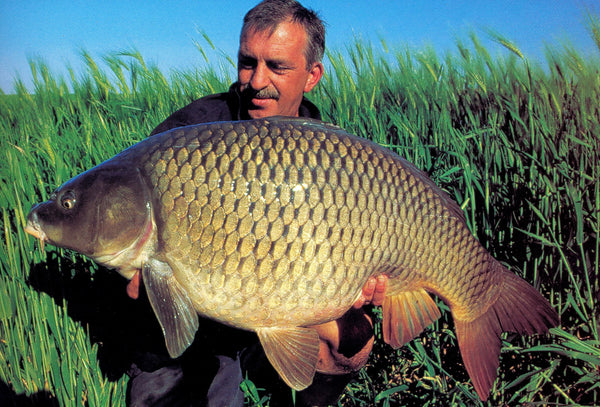
It was Philippe who taught me the art of fishing for one fish at a time, a single-minded approach typical of the man and the way he targets big carp. The idea is to introduce only enough bait to induce one take off a strategically chosen spot for each rod. In effect this mean that you catch that one fish, then set out your stall along identical lines to try to tempt another fish, and a third, forth and so on. It is not a tactic that generates loads of action, but it certainly seems to sort out bigger and thus possibly more cautious, more suspicious carp. This is Phil with a huge common carp caught from the River Danube. Gorgeous, isn't it!
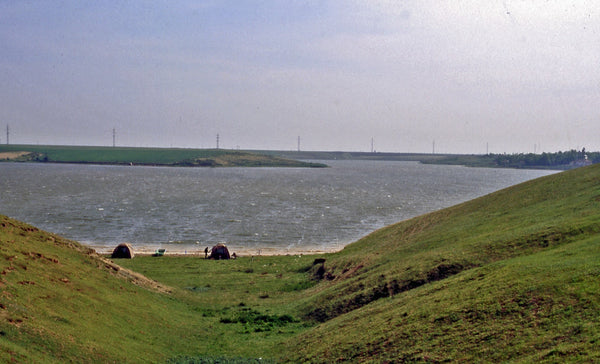
For context please understand that the Romanian lake is over 500 ha (1,200) acres in size. It was created when the valley was flooded to create one of the five huge lakes that lie along the river's course. Extensive searching by echo sounder had revealed a prominent plateau lying half way across the bay that we were fishing. It lies some 150-200m out from the shore and we had marked it down as a very likely spot to ambush one of the shoals of big carp that were known to patrol the bay. Bear in mind that the bay itself is two kilometres long and 500m wide and measures 7 hectares in size. The plateau lies just under half way across the bay.
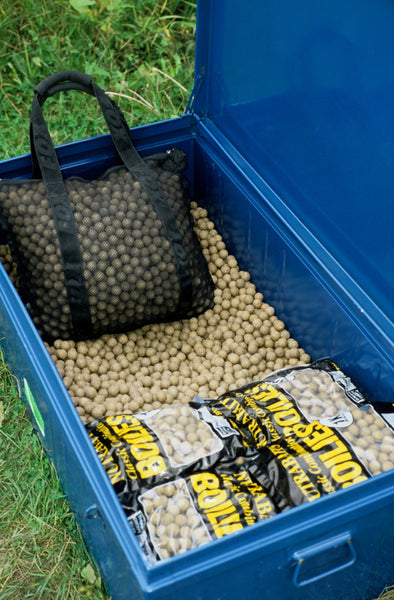
We used a 50/50 blend of ready-mades and home-made bait for the main bait carpet. We both home-rolled about 60kg of base mix each and the resulting baits were air- dried. In both cases the base mix we used was Trigga as were the shelf life baits. I was heavily involved in the development of Trigga and it soon became clear to me that the shelf life baits were just as effective as hand rolled. This is not usually the case in my experience, but with the original version of Trigga it most certainly is.

The Trigga baits I received were nicely finished being quite hard but cutting them open revealed a nice soft centre and it was quite easy to get the baits to 'turn'. This white coating on the outside of the baits is actually the sugars within the bait coming out. Many anglers consider this to be the ultimate in attraction and certainly Trigga was outstanding when it was on the turn.

So yes, while the original Trigga was good, it changed slightly in later years and I found I could boost it by using 10% Robin Red. This is a wheeze you may like to try yourself if you find a slight drop in effectiveness of your current bait. Simply add 10% Robin Red to your mix.

Here you can see Trigga on the left and Trigga with Robin Red on the right.
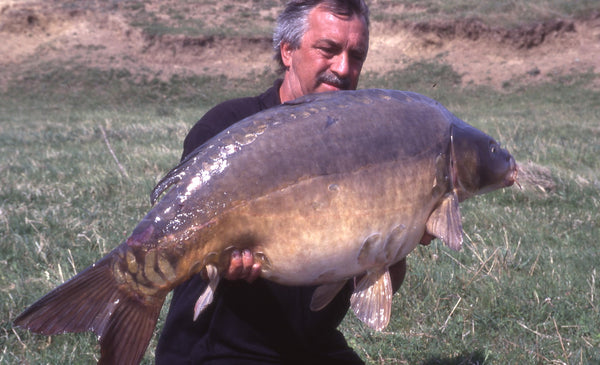
Many carpers are convinced that only the most expensive high quality ingredients are suitable for use in a base mix. Up to a point I agree, but it is also true that inexpensive ingredients mixes are can be very effective. This pic is of Phil with a fat forty-pound mirror caught on a high-energy bait. This Blog (see link) gives some idea of how to use such baits.
https://haiths.com/blogs/fishing-news/inexpensive-base-mixes-1?_pos=26&_sid=c5aa03d96&_ss=r

As no doubt readers of the Haith's Baits Blogs will have gathered I am a massive fan of using paste. It is so versatile and can make the difference between a blank and a red-letter session. There are a number of blogs on our site that can guide you through the advantages of using past and one of the best applications is to use it as a hookbait wrap. Note: In this photo you will see that I have used a two-bait hair rig, the double baits being wrapped in boilie paste to add maximum attraction.
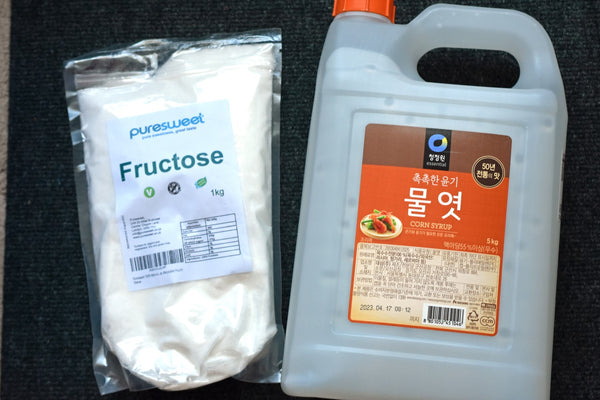
You may have heard the terms 'high-energy' and 'high-fat' used in conjunction with carp baits. This is because such baits are hugely effective, as carp use the fat and carbohydrate components in the bait as energy sources. Monosaccharides (sugars) are especially attractive to carp and they find these two ingredients highly palatable and easy to digest. (You should be able to find both on Amazon.)
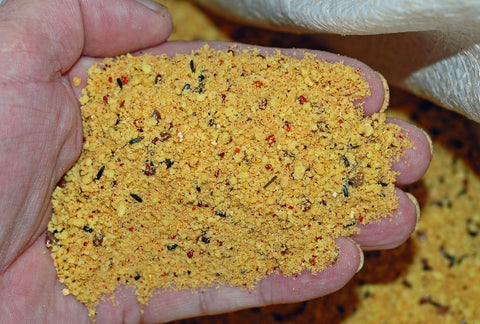
Egg biscuit is an incredible bird food ingredient as it combines a decent level of protein alongside a simple yet very digestible fat source. It is no coincidence that we use it to create two of our top-selling bird foods, Nectarblend, CLO and Red Factor. See those tiny yellow granules in this photo of Red Factor? They are granules of top quality pure dried egg, high in fats and thus are easily converted during digestion to a excellent energy source. They are used in countless base mixes both by the trade and by home rollers and I have lost count of the number of carp I have caught on boilies containing one or both of these ingredients.

TIP: Try using a coffee grinder to reduce the mesh size of the granules.

For all you home rollers out there try this recipe:
25% Yellow Semolina
25% Haiths CLO*
25% Haiths Red Factor*
10% Robin Red
10% Liver Powder
5% Whey Protein Concentrate
* This recipe can be a bit crumbly so it helps if these ingredients are ground down ground down using a coffee grinder.
This recipe will work OK without the need for additional attraction or flavour but I can thoroughly recommend the attractors offered by the Dutch company Feed Stimulants.
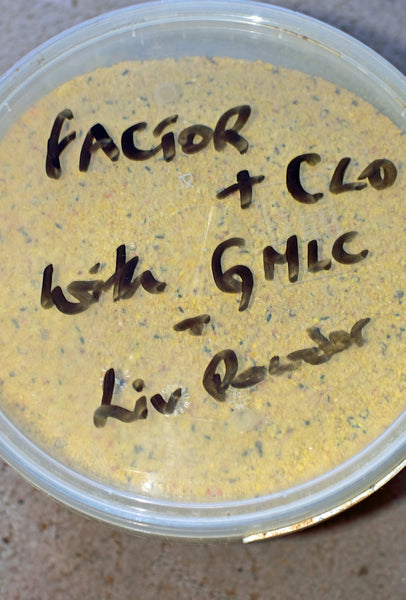
Feed Stimulants' Liver Powder and Green Lipped Muscle Concentrate are among the best carp bait additives I have ever used. (Spot the non-deliberate mistake in this photo.)
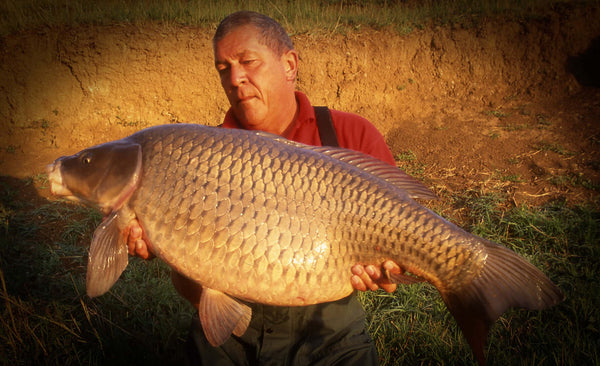
Many apologies for not contributing to these pages for a while. My health has taken a bit of a hit lately and my faculties are not as sharp as they once where. The old grey matter is slowly falling to pieces! It's called getting old!
See you again soon, well sooner than the last time at any rate!
Today I want to show you how to get maximum attraction out of your paste using some of the huge range of natural attractors from the Dutch company Feed Stimulants.
But first we need to assemble the dry mix and in this case that couldn't be easier, as the mix comprises just two ingredients, Red Factor and Coconut Milk Powder. The first is an excellent binder with good nutritional properties as well as a dash of Robin Red; the second is highly soluble with a fantastic coconut smell.
The first job is to weight out the ingredients and I have found that a 60/40 mix of Red Factor and the milk powder to be about right. As it comes Red Factor is quite coarse in nature so it pays to grind most of it down to a find powder. I say 'most' as I like to keep a bit back to use in the last stages of the paste formation. This gives the paste a bit of crunch and also firms up the paste. To reduce the Red Factor to a powder I use a coffee grinder that a barista would be proud of but a standard grinder will do the job too.
The coconut milk powder comes as a very fine 100-mesh powder. I like to pass it through a fine sieve to get rid of any lumps that might have formed. Then it is a case of mixing the two powders together.
Now break your eggs in a bowl and add 5g of Greenshell Lipped Mussel Concentrate and whisk this into the eggs. I know some anglers prefer to add the GLMC to the other dry powder for, they claim, a better distribution, frankly I don't think it make any difference.
Now is also the time to add the primary attractants, which will give the paste a real boost. They will also make it very sweet to the taste as the package includes Liquid Talin and Amino Compound Sweet Fruit. In all I have used six attractors all with their own unique form of attraction, and because they are in a paste rather than a boiled bait, the loose structure of the paste allows the attraction to flood out, boosting the existing pulling power of the soluble coconut milk powder. The full recipe is as follows:
400g finely ground Red Factor + 200g of un-ground Red Factor
400g sieved Coconut Milk Powder
5g Greenshell Lipped Mussel Concentrate
15ml Amino Compound Sweet Fruit
1ml Liquid Talin
1ml Liquid Betaine Anhydrous (trimethylglycine)
15ml Squid Liver Oil
5g Soy Lecithin.
4 eggs
Fish-derived oils are excellent nutritional foods and of them all squid oil is arguable the best. I like to use it quite sparingly at 15ml and I also add 5g of Soy Lecithin to emulsify it. This makes it easier to digest and the fish will be greater benefit from the Omega-3, -4 and -6 fatty acids that this particular fish oil contains. The best way to mix the oil and the lecithin is to use a small pot with the lid screwed on tightly. Shake the pot until the two are well mixed and then add this to the eggs, whisking again to blend in the oil.
You can now add the dry powders a bit at a time to the eggs. Remember, the Red Factor will help the paste to blend together and form a sticky rather sloppy paste.
Now is the time to add the 200g Red Factor that you held in reserve at the start of the process. Kneed well until a firm ball of paste is formed and allow it to 'rest' in a polythene bag for an hour. You will notice how well the paste firms up. Now pop the paste into the fridge still in the polythene bag. It will last at least a month in there but for longer storage I suggest you label the paste and put it in the freezer.
Regardless of how you use it, this Red Factor paste will simply ooze attraction thanks to the solubility of the coconut milk powder and the Feed Stimulants products that are designed solely to make carp baits more attractive.
Finally here are some of the uses to which you can put the paste.
1) As a wrap for the lead, either pendant or inline.
2) As a wrap for the hookbait.
3) As a wrap for both the hookbait and the hook...Don't worry, this works very well and greatly reduces the chance or a tangle.
4) As a hookbait in its own right. You should protect the paste from the attentions of small fry with a section of tights or stockings.
Written by Ken Townley.
